Advanced Corporate Reporting: Earning Management Report Analysis
VerifiedAdded on 2023/04/03
|16
|4032
|114
Report
AI Summary
This report delves into the multifaceted realm of earning management within corporate reporting, exploring its techniques, ethical implications, and consequences. It begins with an abstract that introduces the core concepts, including income smoothing and manipulation of accounting data, often employed to meet company objectives, particularly in the face of financial scandals. A comprehensive literature review is presented, built upon five key theories such as the signal theory, agency theory, and positive accounting theory, to understand how and why managers use these strategies to influence stakeholders. The report examines the incentives driving earning management, both for executives and investors, and investigates factors influencing managers' decisions regarding loss reporting. Key terms like 'window dressing,' 'income smoothing,' and 'the big bath' are defined to provide a clear understanding of the practices discussed. The research methodology relies on secondary data from online journals, offering a qualitative, descriptive analysis of the subject. The report then reviews selected journals, focusing on the incentive methodology and the role of executives and investors. The report concludes by summarizing the key findings and implications of earning management in corporate reporting. The assignment is a literature review of five academic journal papers.
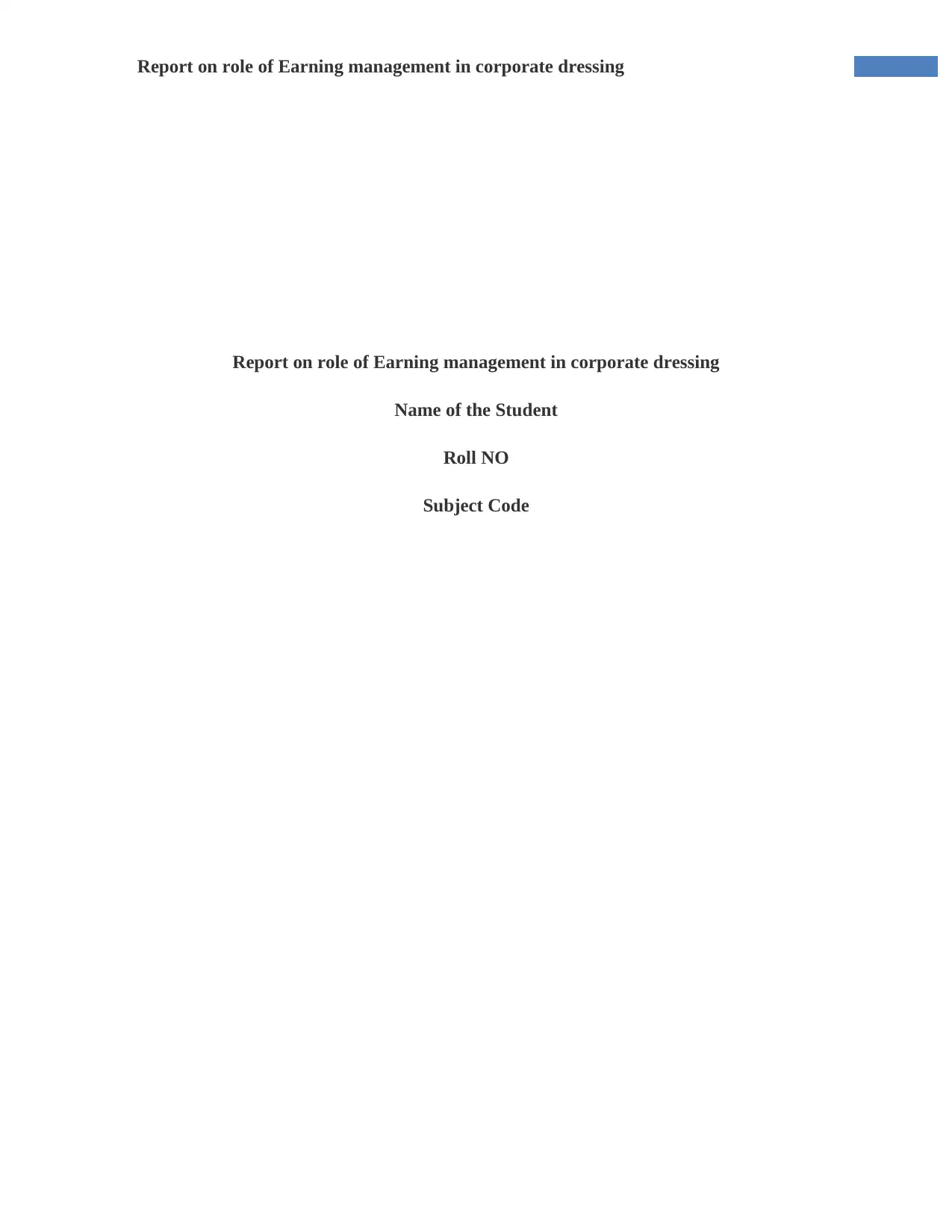
0Report on role of Earning management in corporate dressing
Report on role of Earning management in corporate dressing
Name of the Student
Roll NO
Subject Code
Report on role of Earning management in corporate dressing
Name of the Student
Roll NO
Subject Code
Paraphrase This Document
Need a fresh take? Get an instant paraphrase of this document with our AI Paraphraser

1Report on role of Earning management in corporate dressing
Abstract
The report talks about the issues, consequences and the meaning of terms related to the earning
management. It talks about the importance of having earning management the corporate
accounting world. The financial scandals are highly affected by the usage of the earning
management. It is one of the most widely used terms by the managers to hide or manipulate the
accounting data. They do this to fulfill many objective of the company. It is defines as the
fundamentals of influencing the income of the firm by using the discretionary accruals. Here the
evidence of earning management has been examined in many different context to understand it
better. There are many imperial literature on earning management and to explain the use of the
method to hypothesis of the end result of the financial statement. The report provides a literature
review on earning management based on five theories that exxaplains the use of the earning
management. Thus the aim of the report is to understand the relationship between the opportunist
and information theory as well. How and when the managers use the theory to gain the most out
of it and propose a result that give a positive influence on the stakeholder. The study also looks
at factors why a manager never reports a loss in the statement to the shareholders.
Abstract
The report talks about the issues, consequences and the meaning of terms related to the earning
management. It talks about the importance of having earning management the corporate
accounting world. The financial scandals are highly affected by the usage of the earning
management. It is one of the most widely used terms by the managers to hide or manipulate the
accounting data. They do this to fulfill many objective of the company. It is defines as the
fundamentals of influencing the income of the firm by using the discretionary accruals. Here the
evidence of earning management has been examined in many different context to understand it
better. There are many imperial literature on earning management and to explain the use of the
method to hypothesis of the end result of the financial statement. The report provides a literature
review on earning management based on five theories that exxaplains the use of the earning
management. Thus the aim of the report is to understand the relationship between the opportunist
and information theory as well. How and when the managers use the theory to gain the most out
of it and propose a result that give a positive influence on the stakeholder. The study also looks
at factors why a manager never reports a loss in the statement to the shareholders.
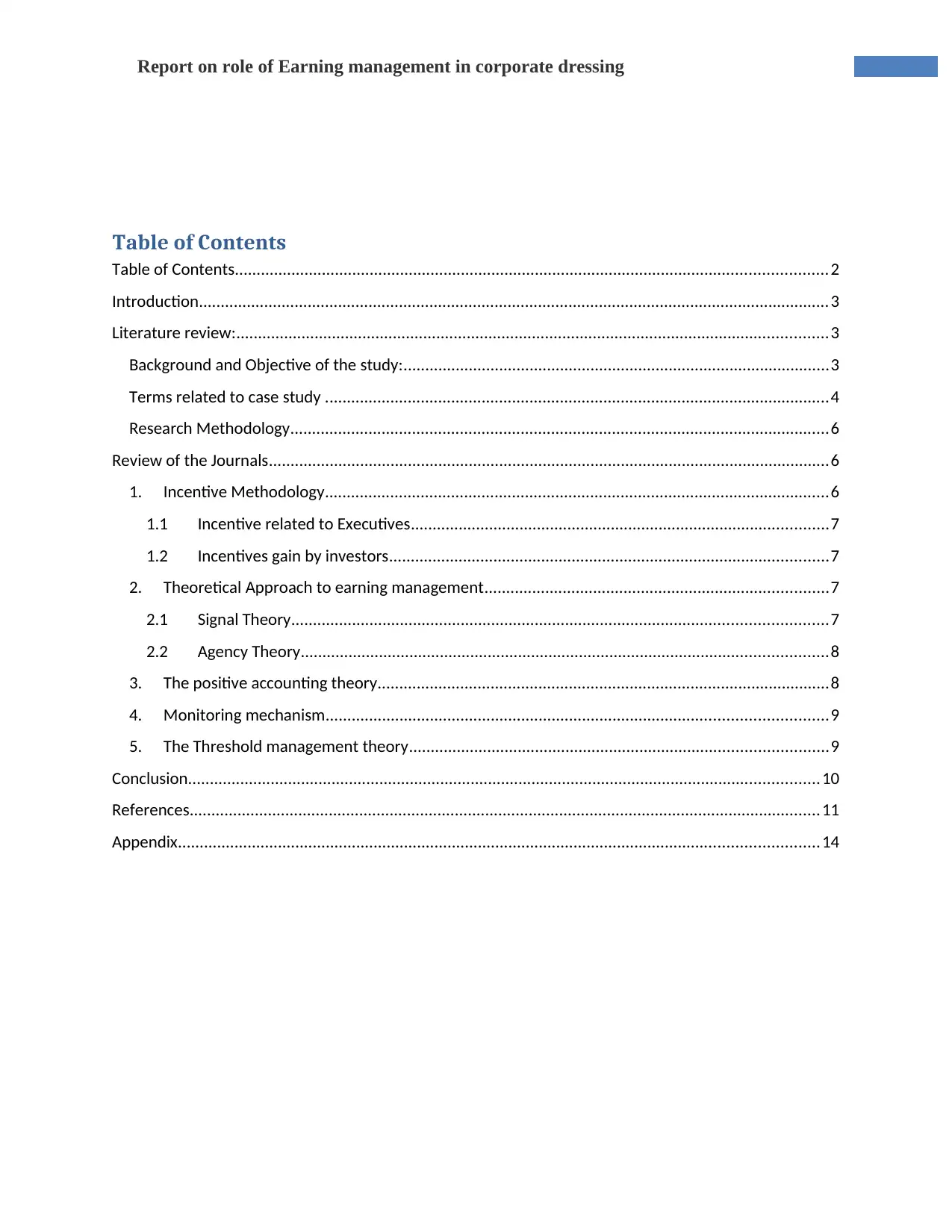
2Report on role of Earning management in corporate dressing
Table of Contents
Table of Contents........................................................................................................................................2
Introduction.................................................................................................................................................3
Literature review:........................................................................................................................................3
Background and Objective of the study:..................................................................................................3
Terms related to case study ....................................................................................................................4
Research Methodology............................................................................................................................6
Review of the Journals.................................................................................................................................6
1. Incentive Methodology....................................................................................................................6
1.1 Incentive related to Executives................................................................................................7
1.2 Incentives gain by investors.....................................................................................................7
2. Theoretical Approach to earning management...............................................................................7
2.1 Signal Theory...........................................................................................................................7
2.2 Agency Theory.........................................................................................................................8
3. The positive accounting theory........................................................................................................8
4. Monitoring mechanism...................................................................................................................9
5. The Threshold management theory................................................................................................9
Conclusion.................................................................................................................................................10
References.................................................................................................................................................11
Appendix...................................................................................................................................................14
Table of Contents
Table of Contents........................................................................................................................................2
Introduction.................................................................................................................................................3
Literature review:........................................................................................................................................3
Background and Objective of the study:..................................................................................................3
Terms related to case study ....................................................................................................................4
Research Methodology............................................................................................................................6
Review of the Journals.................................................................................................................................6
1. Incentive Methodology....................................................................................................................6
1.1 Incentive related to Executives................................................................................................7
1.2 Incentives gain by investors.....................................................................................................7
2. Theoretical Approach to earning management...............................................................................7
2.1 Signal Theory...........................................................................................................................7
2.2 Agency Theory.........................................................................................................................8
3. The positive accounting theory........................................................................................................8
4. Monitoring mechanism...................................................................................................................9
5. The Threshold management theory................................................................................................9
Conclusion.................................................................................................................................................10
References.................................................................................................................................................11
Appendix...................................................................................................................................................14
⊘ This is a preview!⊘
Do you want full access?
Subscribe today to unlock all pages.

Trusted by 1+ million students worldwide

3Report on role of Earning management in corporate dressing
Introduction
Earning is the profit made by the company in the end of the year. To invest in the
company or to buy the stock of company, investors checks the profit of the company. A company
with bad earning prospect will have bad review and investors may hesitate to invest into it. Thus
to make the company lucrative the management uses the earning strategies to manipulate the
profit of the company. It is done to match the numbers with the pre determined figures. Its also
called as income smoothing.
It has been noticed in many cases that earning management is used extensively and
securities & exchange commission has deemed it to be intentional material misstatement practice
if used unethically. In many cases when the income smoothing increases and posses risk of mis
representation on large scale the SEC issues fines and penalties. To a certain point Earning
management is considered legal (Wu 2014).
The approach to manipulate the books of account to make the results looks more lucrative
has damaged the trust of the stakeholders. The incentive to the managers plays a very important
role in earning management miss conduct. Though it’s not illegal but over use has proved to be
fatal to the company itself. There are many examples where the company died due to extensive
use of earning management. The case has been studied how over the years this has been made
protective tool to hide the true reality of the performance of the firms form the stakeholders.
Literature review:
Background and Objective of the study:
The purpose of the study is to understand the ethical use of earning management in the
corporate world. How has it influenced the managers to create a whole new set of accounting for
the stakeholders. Financial scandals like Enron, Gowex, carrilian have shacked the economic
world when examined closely the earning management manipulation was the main reason for all
the fall. Aim of the paper is understand the impact of the fraud on the society, creditors and
shareholders. To investigate the cited paper on this topic why does the managers manipulate
what are the major cause of it. The term and theory used in this paper are reviewed externally.
Also to explore the papers that show the trade-off by managers by two techniques usually used in
Introduction
Earning is the profit made by the company in the end of the year. To invest in the
company or to buy the stock of company, investors checks the profit of the company. A company
with bad earning prospect will have bad review and investors may hesitate to invest into it. Thus
to make the company lucrative the management uses the earning strategies to manipulate the
profit of the company. It is done to match the numbers with the pre determined figures. Its also
called as income smoothing.
It has been noticed in many cases that earning management is used extensively and
securities & exchange commission has deemed it to be intentional material misstatement practice
if used unethically. In many cases when the income smoothing increases and posses risk of mis
representation on large scale the SEC issues fines and penalties. To a certain point Earning
management is considered legal (Wu 2014).
The approach to manipulate the books of account to make the results looks more lucrative
has damaged the trust of the stakeholders. The incentive to the managers plays a very important
role in earning management miss conduct. Though it’s not illegal but over use has proved to be
fatal to the company itself. There are many examples where the company died due to extensive
use of earning management. The case has been studied how over the years this has been made
protective tool to hide the true reality of the performance of the firms form the stakeholders.
Literature review:
Background and Objective of the study:
The purpose of the study is to understand the ethical use of earning management in the
corporate world. How has it influenced the managers to create a whole new set of accounting for
the stakeholders. Financial scandals like Enron, Gowex, carrilian have shacked the economic
world when examined closely the earning management manipulation was the main reason for all
the fall. Aim of the paper is understand the impact of the fraud on the society, creditors and
shareholders. To investigate the cited paper on this topic why does the managers manipulate
what are the major cause of it. The term and theory used in this paper are reviewed externally.
Also to explore the papers that show the trade-off by managers by two techniques usually used in
Paraphrase This Document
Need a fresh take? Get an instant paraphrase of this document with our AI Paraphraser
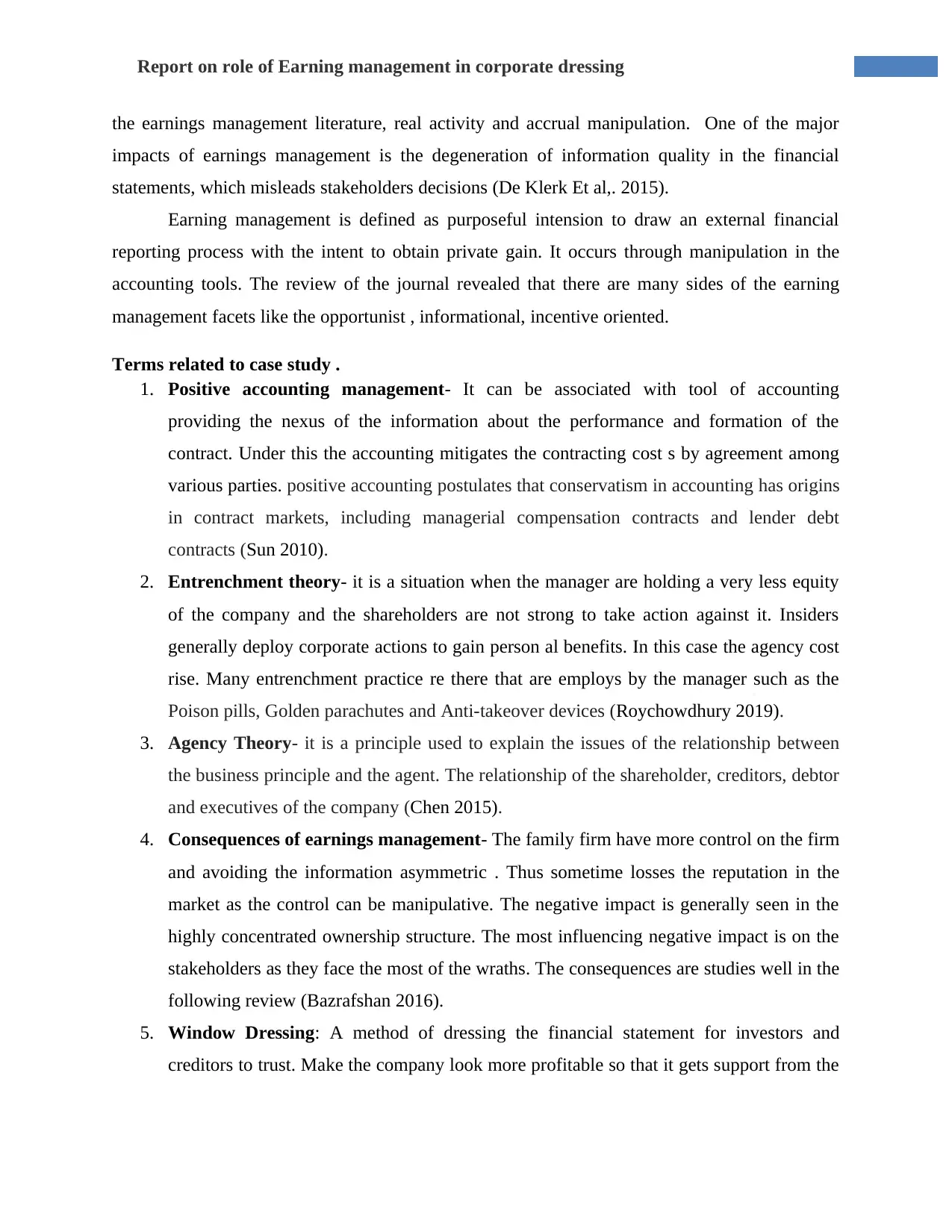
4Report on role of Earning management in corporate dressing
the earnings management literature, real activity and accrual manipulation. One of the major
impacts of earnings management is the degeneration of information quality in the financial
statements, which misleads stakeholders decisions (De Klerk Et al,. 2015).
Earning management is defined as purposeful intension to draw an external financial
reporting process with the intent to obtain private gain. It occurs through manipulation in the
accounting tools. The review of the journal revealed that there are many sides of the earning
management facets like the opportunist , informational, incentive oriented.
Terms related to case study .
1. Positive accounting management- It can be associated with tool of accounting
providing the nexus of the information about the performance and formation of the
contract. Under this the accounting mitigates the contracting cost s by agreement among
various parties. positive accounting postulates that conservatism in accounting has origins
in contract markets, including managerial compensation contracts and lender debt
contracts (Sun 2010).
2. Entrenchment theory- it is a situation when the manager are holding a very less equity
of the company and the shareholders are not strong to take action against it. Insiders
generally deploy corporate actions to gain person al benefits. In this case the agency cost
rise. Many entrenchment practice re there that are employs by the manager such as the
Poison pills, Golden parachutes and Anti-takeover devices (Roychowdhury 2019).
3. Agency Theory- it is a principle used to explain the issues of the relationship between
the business principle and the agent. The relationship of the shareholder, creditors, debtor
and executives of the company (Chen 2015).
4. Consequences of earnings management- The family firm have more control on the firm
and avoiding the information asymmetric . Thus sometime losses the reputation in the
market as the control can be manipulative. The negative impact is generally seen in the
highly concentrated ownership structure. The most influencing negative impact is on the
stakeholders as they face the most of the wraths. The consequences are studies well in the
following review (Bazrafshan 2016).
5. Window Dressing: A method of dressing the financial statement for investors and
creditors to trust. Make the company look more profitable so that it gets support from the
the earnings management literature, real activity and accrual manipulation. One of the major
impacts of earnings management is the degeneration of information quality in the financial
statements, which misleads stakeholders decisions (De Klerk Et al,. 2015).
Earning management is defined as purposeful intension to draw an external financial
reporting process with the intent to obtain private gain. It occurs through manipulation in the
accounting tools. The review of the journal revealed that there are many sides of the earning
management facets like the opportunist , informational, incentive oriented.
Terms related to case study .
1. Positive accounting management- It can be associated with tool of accounting
providing the nexus of the information about the performance and formation of the
contract. Under this the accounting mitigates the contracting cost s by agreement among
various parties. positive accounting postulates that conservatism in accounting has origins
in contract markets, including managerial compensation contracts and lender debt
contracts (Sun 2010).
2. Entrenchment theory- it is a situation when the manager are holding a very less equity
of the company and the shareholders are not strong to take action against it. Insiders
generally deploy corporate actions to gain person al benefits. In this case the agency cost
rise. Many entrenchment practice re there that are employs by the manager such as the
Poison pills, Golden parachutes and Anti-takeover devices (Roychowdhury 2019).
3. Agency Theory- it is a principle used to explain the issues of the relationship between
the business principle and the agent. The relationship of the shareholder, creditors, debtor
and executives of the company (Chen 2015).
4. Consequences of earnings management- The family firm have more control on the firm
and avoiding the information asymmetric . Thus sometime losses the reputation in the
market as the control can be manipulative. The negative impact is generally seen in the
highly concentrated ownership structure. The most influencing negative impact is on the
stakeholders as they face the most of the wraths. The consequences are studies well in the
following review (Bazrafshan 2016).
5. Window Dressing: A method of dressing the financial statement for investors and
creditors to trust. Make the company look more profitable so that it gets support from the
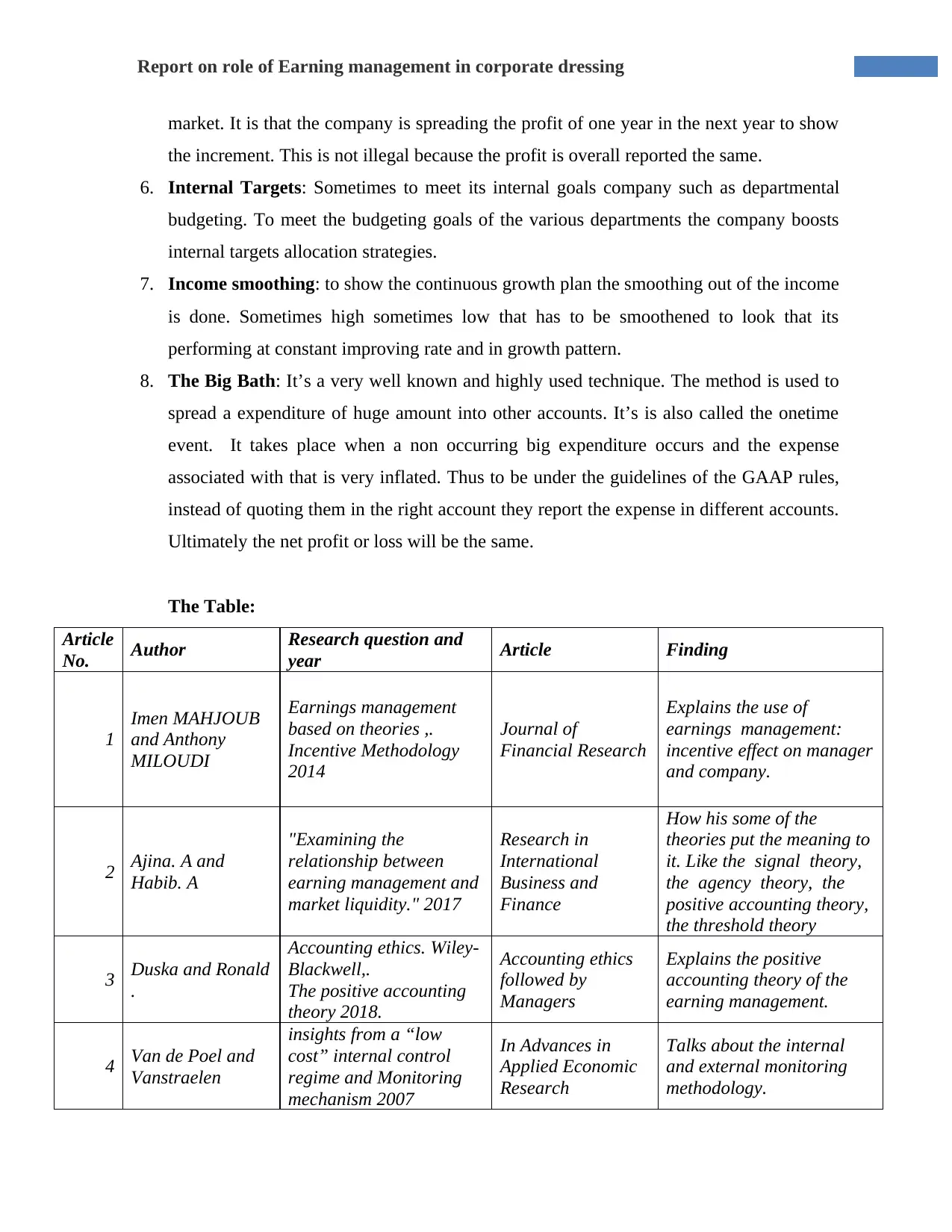
5Report on role of Earning management in corporate dressing
market. It is that the company is spreading the profit of one year in the next year to show
the increment. This is not illegal because the profit is overall reported the same.
6. Internal Targets: Sometimes to meet its internal goals company such as departmental
budgeting. To meet the budgeting goals of the various departments the company boosts
internal targets allocation strategies.
7. Income smoothing: to show the continuous growth plan the smoothing out of the income
is done. Sometimes high sometimes low that has to be smoothened to look that its
performing at constant improving rate and in growth pattern.
8. The Big Bath: It’s a very well known and highly used technique. The method is used to
spread a expenditure of huge amount into other accounts. It’s is also called the onetime
event. It takes place when a non occurring big expenditure occurs and the expense
associated with that is very inflated. Thus to be under the guidelines of the GAAP rules,
instead of quoting them in the right account they report the expense in different accounts.
Ultimately the net profit or loss will be the same.
The Table:
Article
No. Author Research question and
year Article Finding
1
Imen MAHJOUB
and Anthony
MILOUDI
Earnings management
based on theories ,.
Incentive Methodology
2014
Journal of
Financial Research
Explains the use of
earnings management:
incentive effect on manager
and company.
2 Ajina. A and
Habib. A
"Examining the
relationship between
earning management and
market liquidity." 2017
Research in
International
Business and
Finance
How his some of the
theories put the meaning to
it. Like the signal theory,
the agency theory, the
positive accounting theory,
the threshold theory
3 Duska and Ronald
.
Accounting ethics. Wiley-
Blackwell,.
The positive accounting
theory 2018.
Accounting ethics
followed by
Managers
Explains the positive
accounting theory of the
earning management.
4 Van de Poel and
Vanstraelen
insights from a “low
cost” internal control
regime and Monitoring
mechanism 2007
In Advances in
Applied Economic
Research
Talks about the internal
and external monitoring
methodology.
market. It is that the company is spreading the profit of one year in the next year to show
the increment. This is not illegal because the profit is overall reported the same.
6. Internal Targets: Sometimes to meet its internal goals company such as departmental
budgeting. To meet the budgeting goals of the various departments the company boosts
internal targets allocation strategies.
7. Income smoothing: to show the continuous growth plan the smoothing out of the income
is done. Sometimes high sometimes low that has to be smoothened to look that its
performing at constant improving rate and in growth pattern.
8. The Big Bath: It’s a very well known and highly used technique. The method is used to
spread a expenditure of huge amount into other accounts. It’s is also called the onetime
event. It takes place when a non occurring big expenditure occurs and the expense
associated with that is very inflated. Thus to be under the guidelines of the GAAP rules,
instead of quoting them in the right account they report the expense in different accounts.
Ultimately the net profit or loss will be the same.
The Table:
Article
No. Author Research question and
year Article Finding
1
Imen MAHJOUB
and Anthony
MILOUDI
Earnings management
based on theories ,.
Incentive Methodology
2014
Journal of
Financial Research
Explains the use of
earnings management:
incentive effect on manager
and company.
2 Ajina. A and
Habib. A
"Examining the
relationship between
earning management and
market liquidity." 2017
Research in
International
Business and
Finance
How his some of the
theories put the meaning to
it. Like the signal theory,
the agency theory, the
positive accounting theory,
the threshold theory
3 Duska and Ronald
.
Accounting ethics. Wiley-
Blackwell,.
The positive accounting
theory 2018.
Accounting ethics
followed by
Managers
Explains the positive
accounting theory of the
earning management.
4 Van de Poel and
Vanstraelen
insights from a “low
cost” internal control
regime and Monitoring
mechanism 2007
In Advances in
Applied Economic
Research
Talks about the internal
and external monitoring
methodology.
⊘ This is a preview!⊘
Do you want full access?
Subscribe today to unlock all pages.

Trusted by 1+ million students worldwide
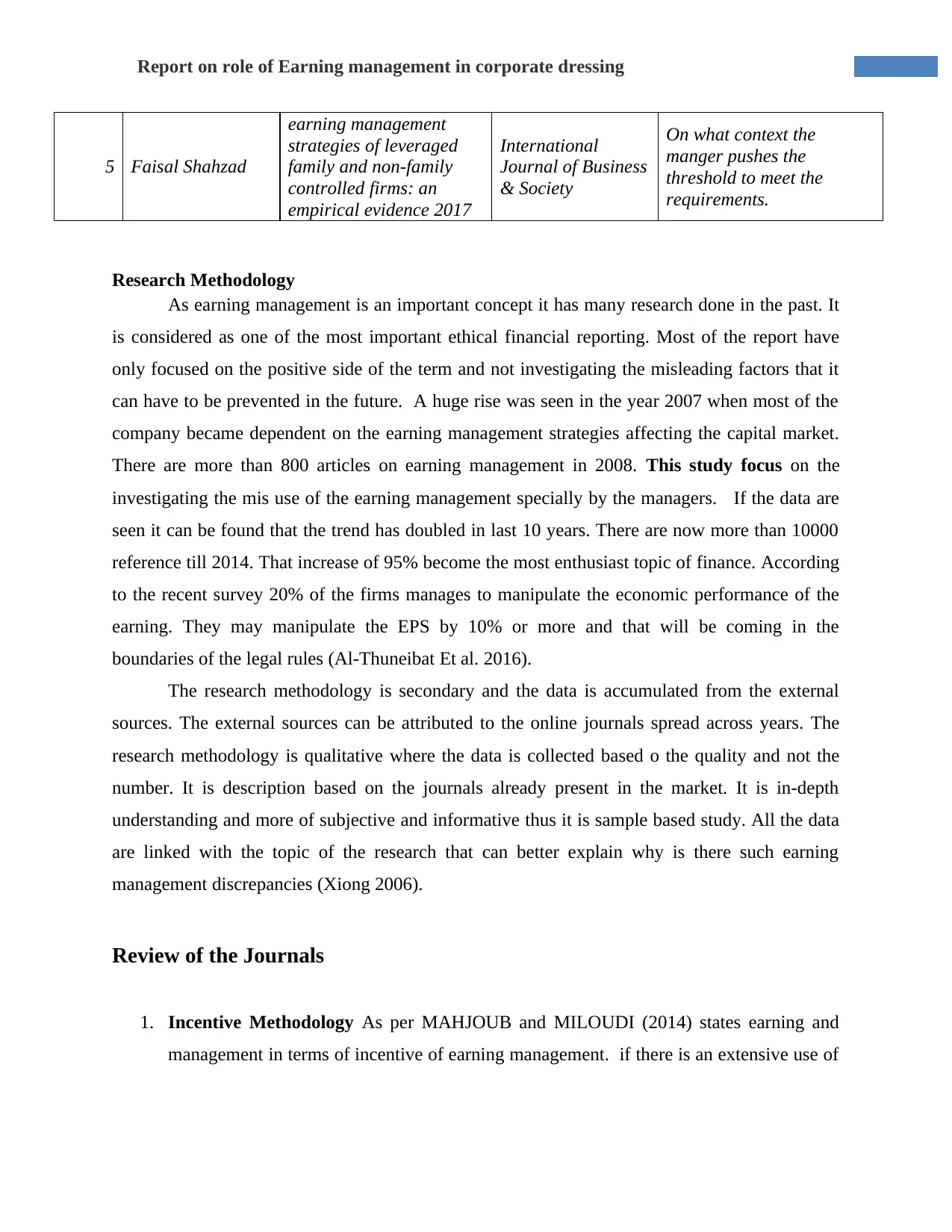
6Report on role of Earning management in corporate dressing
5 Faisal Shahzad
earning management
strategies of leveraged
family and non-family
controlled firms: an
empirical evidence 2017
International
Journal of Business
& Society
On what context the
manger pushes the
threshold to meet the
requirements.
Research Methodology
As earning management is an important concept it has many research done in the past. It
is considered as one of the most important ethical financial reporting. Most of the report have
only focused on the positive side of the term and not investigating the misleading factors that it
can have to be prevented in the future. A huge rise was seen in the year 2007 when most of the
company became dependent on the earning management strategies affecting the capital market.
There are more than 800 articles on earning management in 2008. This study focus on the
investigating the mis use of the earning management specially by the managers. If the data are
seen it can be found that the trend has doubled in last 10 years. There are now more than 10000
reference till 2014. That increase of 95% become the most enthusiast topic of finance. According
to the recent survey 20% of the firms manages to manipulate the economic performance of the
earning. They may manipulate the EPS by 10% or more and that will be coming in the
boundaries of the legal rules (Al-Thuneibat Et al. 2016).
The research methodology is secondary and the data is accumulated from the external
sources. The external sources can be attributed to the online journals spread across years. The
research methodology is qualitative where the data is collected based o the quality and not the
number. It is description based on the journals already present in the market. It is in-depth
understanding and more of subjective and informative thus it is sample based study. All the data
are linked with the topic of the research that can better explain why is there such earning
management discrepancies (Xiong 2006).
Review of the Journals
1. Incentive Methodology As per MAHJOUB and MILOUDI (2014) states earning and
management in terms of incentive of earning management. if there is an extensive use of
5 Faisal Shahzad
earning management
strategies of leveraged
family and non-family
controlled firms: an
empirical evidence 2017
International
Journal of Business
& Society
On what context the
manger pushes the
threshold to meet the
requirements.
Research Methodology
As earning management is an important concept it has many research done in the past. It
is considered as one of the most important ethical financial reporting. Most of the report have
only focused on the positive side of the term and not investigating the misleading factors that it
can have to be prevented in the future. A huge rise was seen in the year 2007 when most of the
company became dependent on the earning management strategies affecting the capital market.
There are more than 800 articles on earning management in 2008. This study focus on the
investigating the mis use of the earning management specially by the managers. If the data are
seen it can be found that the trend has doubled in last 10 years. There are now more than 10000
reference till 2014. That increase of 95% become the most enthusiast topic of finance. According
to the recent survey 20% of the firms manages to manipulate the economic performance of the
earning. They may manipulate the EPS by 10% or more and that will be coming in the
boundaries of the legal rules (Al-Thuneibat Et al. 2016).
The research methodology is secondary and the data is accumulated from the external
sources. The external sources can be attributed to the online journals spread across years. The
research methodology is qualitative where the data is collected based o the quality and not the
number. It is description based on the journals already present in the market. It is in-depth
understanding and more of subjective and informative thus it is sample based study. All the data
are linked with the topic of the research that can better explain why is there such earning
management discrepancies (Xiong 2006).
Review of the Journals
1. Incentive Methodology As per MAHJOUB and MILOUDI (2014) states earning and
management in terms of incentive of earning management. if there is an extensive use of
Paraphrase This Document
Need a fresh take? Get an instant paraphrase of this document with our AI Paraphraser
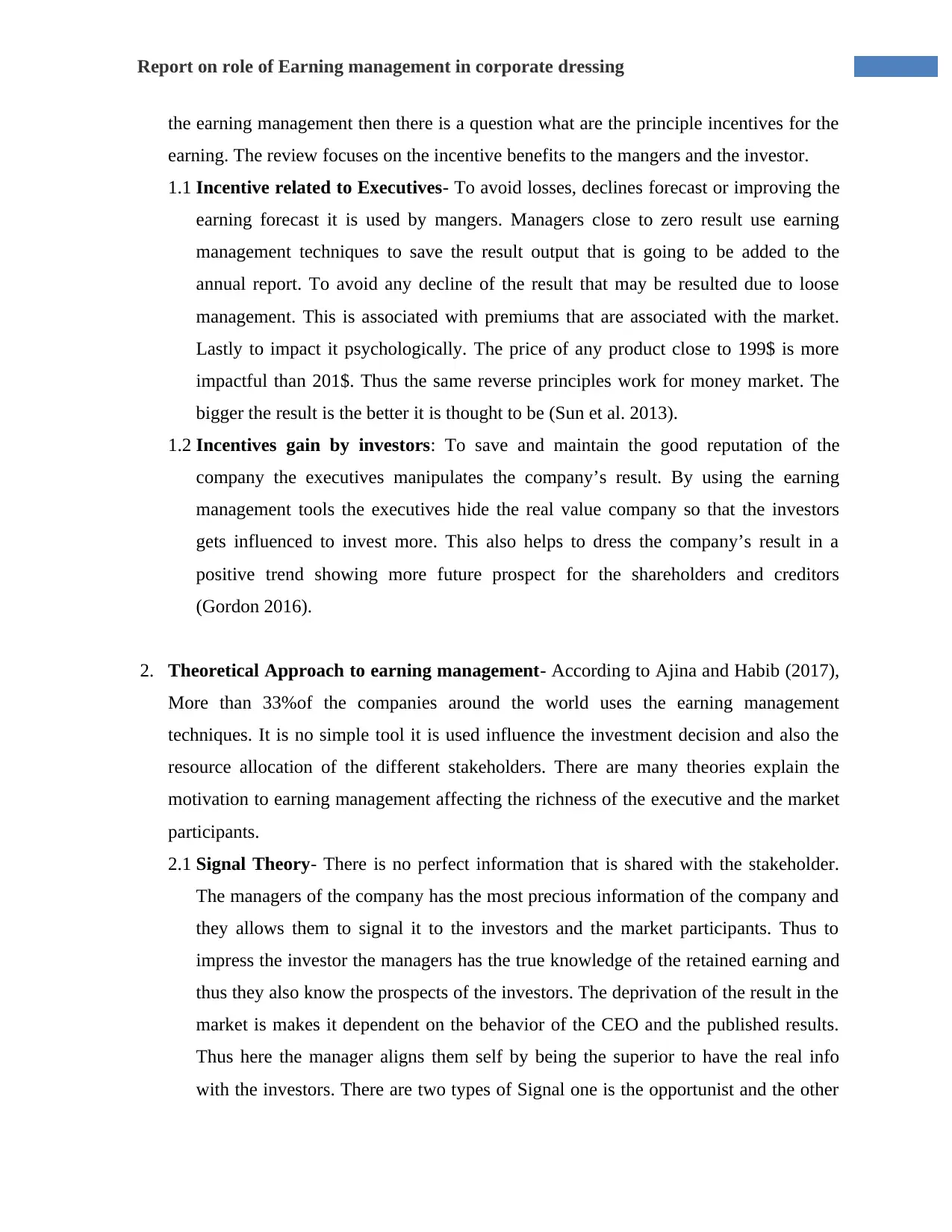
7Report on role of Earning management in corporate dressing
the earning management then there is a question what are the principle incentives for the
earning. The review focuses on the incentive benefits to the mangers and the investor.
1.1 Incentive related to Executives- To avoid losses, declines forecast or improving the
earning forecast it is used by mangers. Managers close to zero result use earning
management techniques to save the result output that is going to be added to the
annual report. To avoid any decline of the result that may be resulted due to loose
management. This is associated with premiums that are associated with the market.
Lastly to impact it psychologically. The price of any product close to 199$ is more
impactful than 201$. Thus the same reverse principles work for money market. The
bigger the result is the better it is thought to be (Sun et al. 2013).
1.2 Incentives gain by investors: To save and maintain the good reputation of the
company the executives manipulates the company’s result. By using the earning
management tools the executives hide the real value company so that the investors
gets influenced to invest more. This also helps to dress the company’s result in a
positive trend showing more future prospect for the shareholders and creditors
(Gordon 2016).
2. Theoretical Approach to earning management- According to Ajina and Habib (2017),
More than 33%of the companies around the world uses the earning management
techniques. It is no simple tool it is used influence the investment decision and also the
resource allocation of the different stakeholders. There are many theories explain the
motivation to earning management affecting the richness of the executive and the market
participants.
2.1 Signal Theory- There is no perfect information that is shared with the stakeholder.
The managers of the company has the most precious information of the company and
they allows them to signal it to the investors and the market participants. Thus to
impress the investor the managers has the true knowledge of the retained earning and
thus they also know the prospects of the investors. The deprivation of the result in the
market is makes it dependent on the behavior of the CEO and the published results.
Thus here the manager aligns them self by being the superior to have the real info
with the investors. There are two types of Signal one is the opportunist and the other
the earning management then there is a question what are the principle incentives for the
earning. The review focuses on the incentive benefits to the mangers and the investor.
1.1 Incentive related to Executives- To avoid losses, declines forecast or improving the
earning forecast it is used by mangers. Managers close to zero result use earning
management techniques to save the result output that is going to be added to the
annual report. To avoid any decline of the result that may be resulted due to loose
management. This is associated with premiums that are associated with the market.
Lastly to impact it psychologically. The price of any product close to 199$ is more
impactful than 201$. Thus the same reverse principles work for money market. The
bigger the result is the better it is thought to be (Sun et al. 2013).
1.2 Incentives gain by investors: To save and maintain the good reputation of the
company the executives manipulates the company’s result. By using the earning
management tools the executives hide the real value company so that the investors
gets influenced to invest more. This also helps to dress the company’s result in a
positive trend showing more future prospect for the shareholders and creditors
(Gordon 2016).
2. Theoretical Approach to earning management- According to Ajina and Habib (2017),
More than 33%of the companies around the world uses the earning management
techniques. It is no simple tool it is used influence the investment decision and also the
resource allocation of the different stakeholders. There are many theories explain the
motivation to earning management affecting the richness of the executive and the market
participants.
2.1 Signal Theory- There is no perfect information that is shared with the stakeholder.
The managers of the company has the most precious information of the company and
they allows them to signal it to the investors and the market participants. Thus to
impress the investor the managers has the true knowledge of the retained earning and
thus they also know the prospects of the investors. The deprivation of the result in the
market is makes it dependent on the behavior of the CEO and the published results.
Thus here the manager aligns them self by being the superior to have the real info
with the investors. There are two types of Signal one is the opportunist and the other
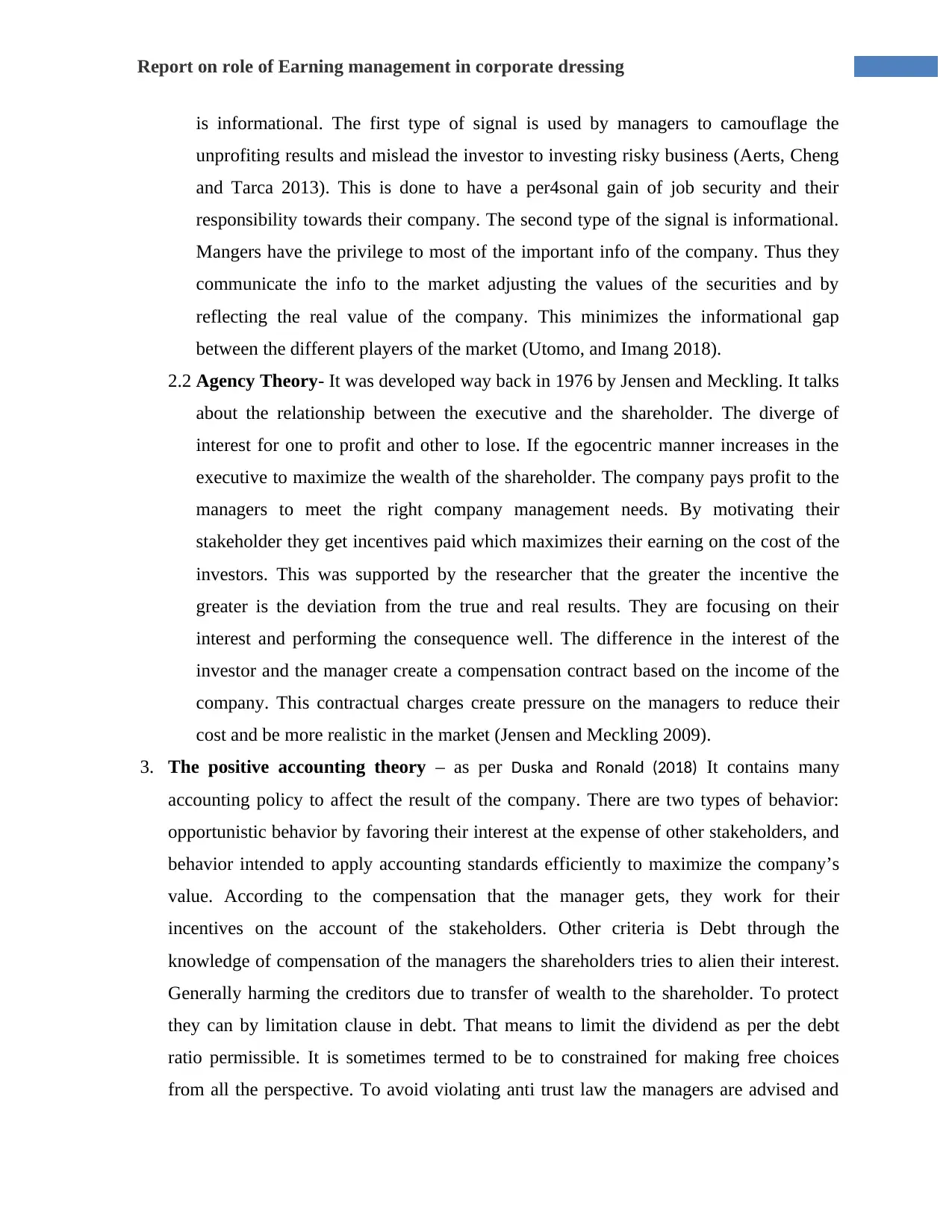
8Report on role of Earning management in corporate dressing
is informational. The first type of signal is used by managers to camouflage the
unprofiting results and mislead the investor to investing risky business (Aerts, Cheng
and Tarca 2013). This is done to have a per4sonal gain of job security and their
responsibility towards their company. The second type of the signal is informational.
Mangers have the privilege to most of the important info of the company. Thus they
communicate the info to the market adjusting the values of the securities and by
reflecting the real value of the company. This minimizes the informational gap
between the different players of the market (Utomo, and Imang 2018).
2.2 Agency Theory- It was developed way back in 1976 by Jensen and Meckling. It talks
about the relationship between the executive and the shareholder. The diverge of
interest for one to profit and other to lose. If the egocentric manner increases in the
executive to maximize the wealth of the shareholder. The company pays profit to the
managers to meet the right company management needs. By motivating their
stakeholder they get incentives paid which maximizes their earning on the cost of the
investors. This was supported by the researcher that the greater the incentive the
greater is the deviation from the true and real results. They are focusing on their
interest and performing the consequence well. The difference in the interest of the
investor and the manager create a compensation contract based on the income of the
company. This contractual charges create pressure on the managers to reduce their
cost and be more realistic in the market (Jensen and Meckling 2009).
3. The positive accounting theory – as per Duska and Ronald (2018) It contains many
accounting policy to affect the result of the company. There are two types of behavior:
opportunistic behavior by favoring their interest at the expense of other stakeholders, and
behavior intended to apply accounting standards efficiently to maximize the company’s
value. According to the compensation that the manager gets, they work for their
incentives on the account of the stakeholders. Other criteria is Debt through the
knowledge of compensation of the managers the shareholders tries to alien their interest.
Generally harming the creditors due to transfer of wealth to the shareholder. To protect
they can by limitation clause in debt. That means to limit the dividend as per the debt
ratio permissible. It is sometimes termed to be to constrained for making free choices
from all the perspective. To avoid violating anti trust law the managers are advised and
is informational. The first type of signal is used by managers to camouflage the
unprofiting results and mislead the investor to investing risky business (Aerts, Cheng
and Tarca 2013). This is done to have a per4sonal gain of job security and their
responsibility towards their company. The second type of the signal is informational.
Mangers have the privilege to most of the important info of the company. Thus they
communicate the info to the market adjusting the values of the securities and by
reflecting the real value of the company. This minimizes the informational gap
between the different players of the market (Utomo, and Imang 2018).
2.2 Agency Theory- It was developed way back in 1976 by Jensen and Meckling. It talks
about the relationship between the executive and the shareholder. The diverge of
interest for one to profit and other to lose. If the egocentric manner increases in the
executive to maximize the wealth of the shareholder. The company pays profit to the
managers to meet the right company management needs. By motivating their
stakeholder they get incentives paid which maximizes their earning on the cost of the
investors. This was supported by the researcher that the greater the incentive the
greater is the deviation from the true and real results. They are focusing on their
interest and performing the consequence well. The difference in the interest of the
investor and the manager create a compensation contract based on the income of the
company. This contractual charges create pressure on the managers to reduce their
cost and be more realistic in the market (Jensen and Meckling 2009).
3. The positive accounting theory – as per Duska and Ronald (2018) It contains many
accounting policy to affect the result of the company. There are two types of behavior:
opportunistic behavior by favoring their interest at the expense of other stakeholders, and
behavior intended to apply accounting standards efficiently to maximize the company’s
value. According to the compensation that the manager gets, they work for their
incentives on the account of the stakeholders. Other criteria is Debt through the
knowledge of compensation of the managers the shareholders tries to alien their interest.
Generally harming the creditors due to transfer of wealth to the shareholder. To protect
they can by limitation clause in debt. That means to limit the dividend as per the debt
ratio permissible. It is sometimes termed to be to constrained for making free choices
from all the perspective. To avoid violating anti trust law the managers are advised and
⊘ This is a preview!⊘
Do you want full access?
Subscribe today to unlock all pages.

Trusted by 1+ million students worldwide
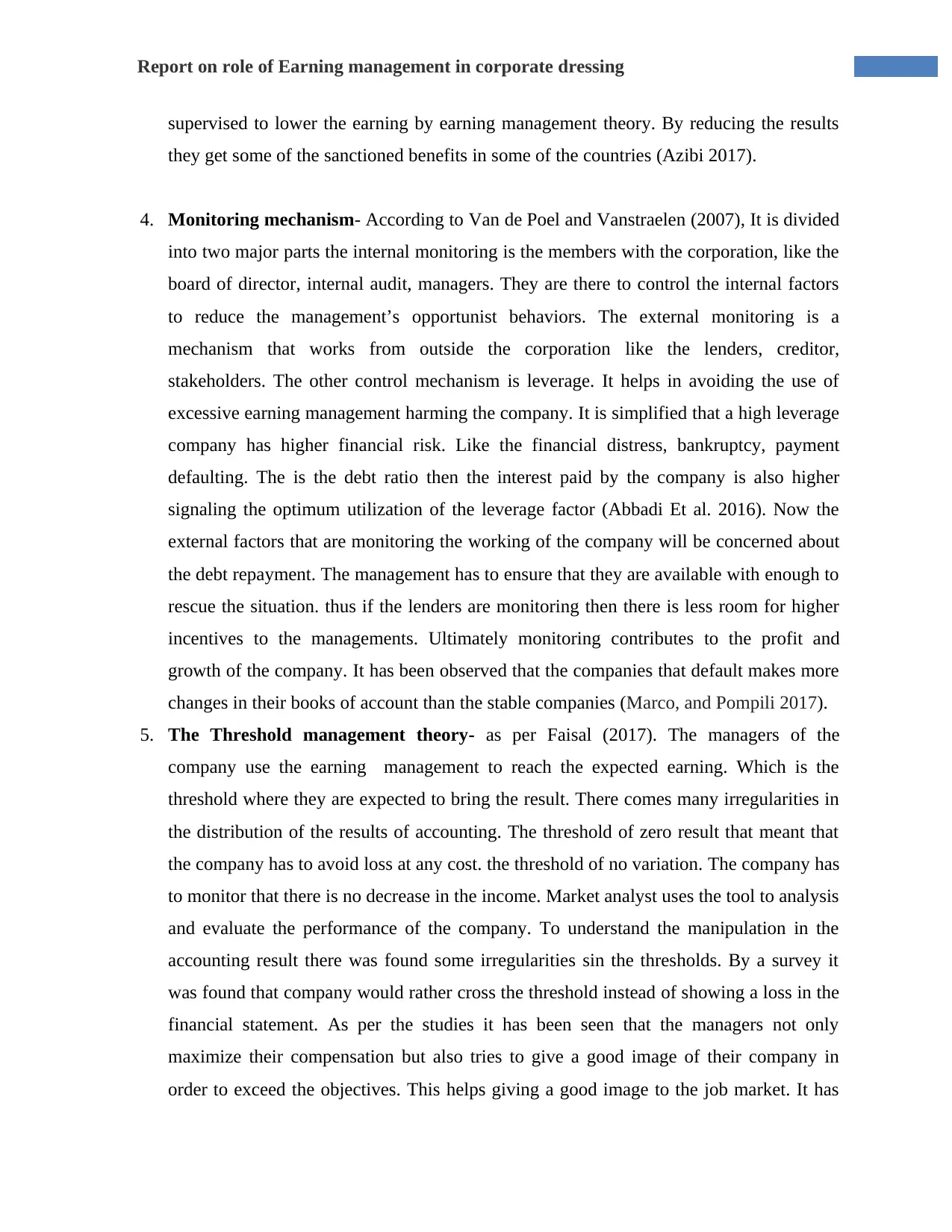
9Report on role of Earning management in corporate dressing
supervised to lower the earning by earning management theory. By reducing the results
they get some of the sanctioned benefits in some of the countries (Azibi 2017).
4. Monitoring mechanism- According to Van de Poel and Vanstraelen (2007), It is divided
into two major parts the internal monitoring is the members with the corporation, like the
board of director, internal audit, managers. They are there to control the internal factors
to reduce the management’s opportunist behaviors. The external monitoring is a
mechanism that works from outside the corporation like the lenders, creditor,
stakeholders. The other control mechanism is leverage. It helps in avoiding the use of
excessive earning management harming the company. It is simplified that a high leverage
company has higher financial risk. Like the financial distress, bankruptcy, payment
defaulting. The is the debt ratio then the interest paid by the company is also higher
signaling the optimum utilization of the leverage factor (Abbadi Et al. 2016). Now the
external factors that are monitoring the working of the company will be concerned about
the debt repayment. The management has to ensure that they are available with enough to
rescue the situation. thus if the lenders are monitoring then there is less room for higher
incentives to the managements. Ultimately monitoring contributes to the profit and
growth of the company. It has been observed that the companies that default makes more
changes in their books of account than the stable companies (Marco, and Pompili 2017).
5. The Threshold management theory- as per Faisal (2017). The managers of the
company use the earning management to reach the expected earning. Which is the
threshold where they are expected to bring the result. There comes many irregularities in
the distribution of the results of accounting. The threshold of zero result that meant that
the company has to avoid loss at any cost. the threshold of no variation. The company has
to monitor that there is no decrease in the income. Market analyst uses the tool to analysis
and evaluate the performance of the company. To understand the manipulation in the
accounting result there was found some irregularities sin the thresholds. By a survey it
was found that company would rather cross the threshold instead of showing a loss in the
financial statement. As per the studies it has been seen that the managers not only
maximize their compensation but also tries to give a good image of their company in
order to exceed the objectives. This helps giving a good image to the job market. It has
supervised to lower the earning by earning management theory. By reducing the results
they get some of the sanctioned benefits in some of the countries (Azibi 2017).
4. Monitoring mechanism- According to Van de Poel and Vanstraelen (2007), It is divided
into two major parts the internal monitoring is the members with the corporation, like the
board of director, internal audit, managers. They are there to control the internal factors
to reduce the management’s opportunist behaviors. The external monitoring is a
mechanism that works from outside the corporation like the lenders, creditor,
stakeholders. The other control mechanism is leverage. It helps in avoiding the use of
excessive earning management harming the company. It is simplified that a high leverage
company has higher financial risk. Like the financial distress, bankruptcy, payment
defaulting. The is the debt ratio then the interest paid by the company is also higher
signaling the optimum utilization of the leverage factor (Abbadi Et al. 2016). Now the
external factors that are monitoring the working of the company will be concerned about
the debt repayment. The management has to ensure that they are available with enough to
rescue the situation. thus if the lenders are monitoring then there is less room for higher
incentives to the managements. Ultimately monitoring contributes to the profit and
growth of the company. It has been observed that the companies that default makes more
changes in their books of account than the stable companies (Marco, and Pompili 2017).
5. The Threshold management theory- as per Faisal (2017). The managers of the
company use the earning management to reach the expected earning. Which is the
threshold where they are expected to bring the result. There comes many irregularities in
the distribution of the results of accounting. The threshold of zero result that meant that
the company has to avoid loss at any cost. the threshold of no variation. The company has
to monitor that there is no decrease in the income. Market analyst uses the tool to analysis
and evaluate the performance of the company. To understand the manipulation in the
accounting result there was found some irregularities sin the thresholds. By a survey it
was found that company would rather cross the threshold instead of showing a loss in the
financial statement. As per the studies it has been seen that the managers not only
maximize their compensation but also tries to give a good image of their company in
order to exceed the objectives. This helps giving a good image to the job market. It has
Paraphrase This Document
Need a fresh take? Get an instant paraphrase of this document with our AI Paraphraser
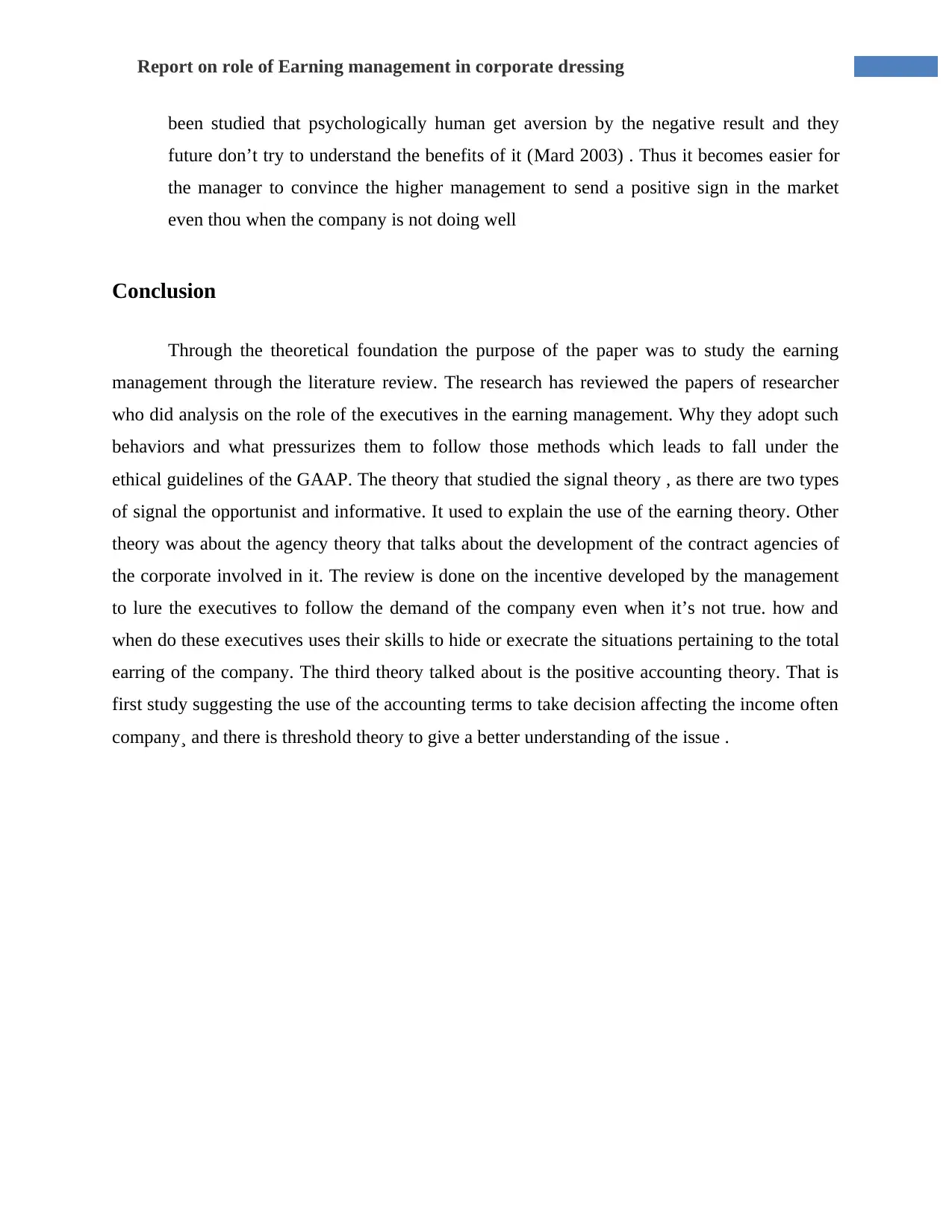
10Report on role of Earning management in corporate dressing
been studied that psychologically human get aversion by the negative result and they
future don’t try to understand the benefits of it (Mard 2003) . Thus it becomes easier for
the manager to convince the higher management to send a positive sign in the market
even thou when the company is not doing well
Conclusion
Through the theoretical foundation the purpose of the paper was to study the earning
management through the literature review. The research has reviewed the papers of researcher
who did analysis on the role of the executives in the earning management. Why they adopt such
behaviors and what pressurizes them to follow those methods which leads to fall under the
ethical guidelines of the GAAP. The theory that studied the signal theory , as there are two types
of signal the opportunist and informative. It used to explain the use of the earning theory. Other
theory was about the agency theory that talks about the development of the contract agencies of
the corporate involved in it. The review is done on the incentive developed by the management
to lure the executives to follow the demand of the company even when it’s not true. how and
when do these executives uses their skills to hide or execrate the situations pertaining to the total
earring of the company. The third theory talked about is the positive accounting theory. That is
first study suggesting the use of the accounting terms to take decision affecting the income often
company¸ and there is threshold theory to give a better understanding of the issue .
been studied that psychologically human get aversion by the negative result and they
future don’t try to understand the benefits of it (Mard 2003) . Thus it becomes easier for
the manager to convince the higher management to send a positive sign in the market
even thou when the company is not doing well
Conclusion
Through the theoretical foundation the purpose of the paper was to study the earning
management through the literature review. The research has reviewed the papers of researcher
who did analysis on the role of the executives in the earning management. Why they adopt such
behaviors and what pressurizes them to follow those methods which leads to fall under the
ethical guidelines of the GAAP. The theory that studied the signal theory , as there are two types
of signal the opportunist and informative. It used to explain the use of the earning theory. Other
theory was about the agency theory that talks about the development of the contract agencies of
the corporate involved in it. The review is done on the incentive developed by the management
to lure the executives to follow the demand of the company even when it’s not true. how and
when do these executives uses their skills to hide or execrate the situations pertaining to the total
earring of the company. The third theory talked about is the positive accounting theory. That is
first study suggesting the use of the accounting terms to take decision affecting the income often
company¸ and there is threshold theory to give a better understanding of the issue .
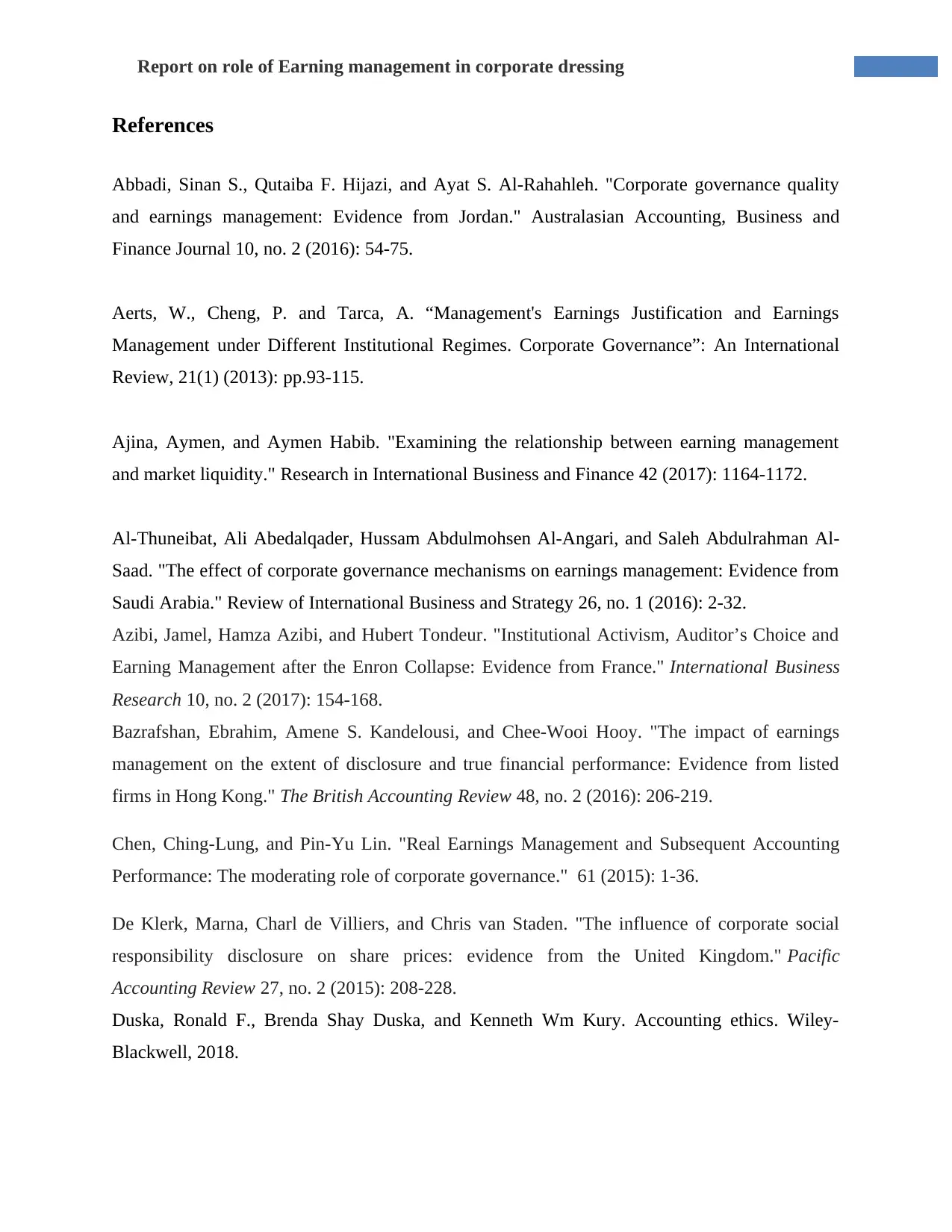
11Report on role of Earning management in corporate dressing
References
Abbadi, Sinan S., Qutaiba F. Hijazi, and Ayat S. Al-Rahahleh. "Corporate governance quality
and earnings management: Evidence from Jordan." Australasian Accounting, Business and
Finance Journal 10, no. 2 (2016): 54-75.
Aerts, W., Cheng, P. and Tarca, A. “Management's Earnings Justification and Earnings
Management under Different Institutional Regimes. Corporate Governance”: An International
Review, 21(1) (2013): pp.93-115.
Ajina, Aymen, and Aymen Habib. "Examining the relationship between earning management
and market liquidity." Research in International Business and Finance 42 (2017): 1164-1172.
Al-Thuneibat, Ali Abedalqader, Hussam Abdulmohsen Al-Angari, and Saleh Abdulrahman Al-
Saad. "The effect of corporate governance mechanisms on earnings management: Evidence from
Saudi Arabia." Review of International Business and Strategy 26, no. 1 (2016): 2-32.
Azibi, Jamel, Hamza Azibi, and Hubert Tondeur. "Institutional Activism, Auditor’s Choice and
Earning Management after the Enron Collapse: Evidence from France." International Business
Research 10, no. 2 (2017): 154-168.
Bazrafshan, Ebrahim, Amene S. Kandelousi, and Chee-Wooi Hooy. "The impact of earnings
management on the extent of disclosure and true financial performance: Evidence from listed
firms in Hong Kong." The British Accounting Review 48, no. 2 (2016): 206-219.
Chen, Ching-Lung, and Pin-Yu Lin. "Real Earnings Management and Subsequent Accounting
Performance: The moderating role of corporate governance." 61 (2015): 1-36.
De Klerk, Marna, Charl de Villiers, and Chris van Staden. "The influence of corporate social
responsibility disclosure on share prices: evidence from the United Kingdom." Pacific
Accounting Review 27, no. 2 (2015): 208-228.
Duska, Ronald F., Brenda Shay Duska, and Kenneth Wm Kury. Accounting ethics. Wiley-
Blackwell, 2018.
References
Abbadi, Sinan S., Qutaiba F. Hijazi, and Ayat S. Al-Rahahleh. "Corporate governance quality
and earnings management: Evidence from Jordan." Australasian Accounting, Business and
Finance Journal 10, no. 2 (2016): 54-75.
Aerts, W., Cheng, P. and Tarca, A. “Management's Earnings Justification and Earnings
Management under Different Institutional Regimes. Corporate Governance”: An International
Review, 21(1) (2013): pp.93-115.
Ajina, Aymen, and Aymen Habib. "Examining the relationship between earning management
and market liquidity." Research in International Business and Finance 42 (2017): 1164-1172.
Al-Thuneibat, Ali Abedalqader, Hussam Abdulmohsen Al-Angari, and Saleh Abdulrahman Al-
Saad. "The effect of corporate governance mechanisms on earnings management: Evidence from
Saudi Arabia." Review of International Business and Strategy 26, no. 1 (2016): 2-32.
Azibi, Jamel, Hamza Azibi, and Hubert Tondeur. "Institutional Activism, Auditor’s Choice and
Earning Management after the Enron Collapse: Evidence from France." International Business
Research 10, no. 2 (2017): 154-168.
Bazrafshan, Ebrahim, Amene S. Kandelousi, and Chee-Wooi Hooy. "The impact of earnings
management on the extent of disclosure and true financial performance: Evidence from listed
firms in Hong Kong." The British Accounting Review 48, no. 2 (2016): 206-219.
Chen, Ching-Lung, and Pin-Yu Lin. "Real Earnings Management and Subsequent Accounting
Performance: The moderating role of corporate governance." 61 (2015): 1-36.
De Klerk, Marna, Charl de Villiers, and Chris van Staden. "The influence of corporate social
responsibility disclosure on share prices: evidence from the United Kingdom." Pacific
Accounting Review 27, no. 2 (2015): 208-228.
Duska, Ronald F., Brenda Shay Duska, and Kenneth Wm Kury. Accounting ethics. Wiley-
Blackwell, 2018.
⊘ This is a preview!⊘
Do you want full access?
Subscribe today to unlock all pages.

Trusted by 1+ million students worldwide
1 out of 16
Related Documents
Your All-in-One AI-Powered Toolkit for Academic Success.
+13062052269
info@desklib.com
Available 24*7 on WhatsApp / Email
![[object Object]](/_next/static/media/star-bottom.7253800d.svg)
Unlock your academic potential
Copyright © 2020–2025 A2Z Services. All Rights Reserved. Developed and managed by ZUCOL.





